Are wolves good for business?
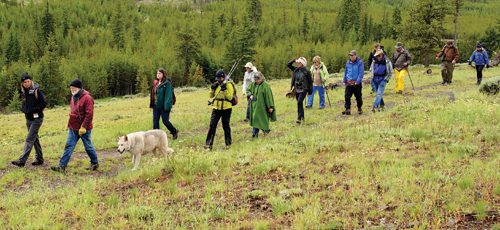 |
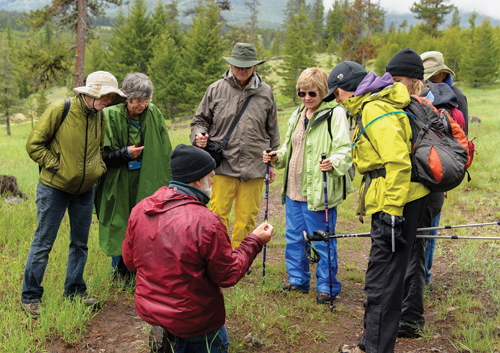 |
Top: Members of Oregon Wild’s Wolf Rendezvous tour hike through wolf country in Eastern Oregon in June.Above: Guide Wally Sykes (kneeling) displays elk hair and bone fragments commonly found in wolf scat.Below: Wolfprint: A Wolf paw is bigger than a dog’s, almost the size of a man’s fist.// Photos by Joseph Eastburn |
 |
“Hot diggety, that’s fresh,” exclaims 67-year-old Wally Sykes, a longtime Wallowa County resident whose family used to hunt wolves in Alaska. He points to a pile of wolf scat on the disused forest service road in the Wallowa-Whitman National Forest in Eastern Oregon where we are hiking. Larger than a dog’s, the clumped scat is tapered at the ends and full of reddish elk hair and small bone fragments.
Sykes points to the flies buzzing around it. “Can’t be more than 12 hours old, maybe less,” he muses, rubbing the white stubble on his chin and quickening his pace.
Though he grew up shooting woodchucks for fun, Sykes has become an advocate for wolves and other wildlife in Eastern Oregon, the heartbreakingly beautiful region far east of the Cascade mountains that comprises about half the state’s land but has a population of only some 100,000 people, depending how you tally it.
The backbone of Eastern Oregon’s economy has historically been mining, logging and agriculture. As mining became almost nonexistent and the timber industry has declined, the region has been reinventing itself in recent years, advertising its natural beauty, outdoor recreation and abundant wildlife to attract visitors.
Sykes — who volunteers as a guide to college kids from Whitman, graduate students from Oregon State University, documentary filmmakers and journalists who want to learn more about wolf behavior and habitat — believes the presence of wolves is good for Oregon’s ecology and economy.
He has also been lending a hand as a volunteer to Oregon Wild, a state-based environmental organization spearheading an initiative to prove to business people — including ranchers, farmers, recreation outfitters, hotel owners and other stakeholders — that wolf tourism is one way to attract even more ecotourism dollars and grow the economy in one of the remotest and hardest-to-access parts of the state.
But while most Eastern Oregonians agree that the expansion of tourism is a benefit to the economy, using wolves to bait visitors, so to speak, is a much more sensitive issue. “Tourism in general is a really important diversification of the economy,” explains Sara Miller, economic development specialist for the Northeast Oregon Economic Development District.
Miller points to the reinvention of Joseph, Oregon, as an art mecca with bronze statues lining the main street, cafés serving free-range chicken soup with rice, and handmade chocolates sold in locally made wooden boxes, as an example of an Eastern Oregon town that is successfully attracting visitors who spend their money locally.
“Our tourism is natural resource-based,” she says. “Whether it’s cultural tourism, ecotourism or agri-tourism, people are coming here because of the outdoor assets we have.”
At the same time, Miller — who co-owns a small ranch with her husband in Wallowa County — says the phenomenon of tourists coming to Eastern Oregon specifically to see the wolves is very controversial.
“There’s a lot of variation in people’s opinions and how they feel about it.” Indeed, spend a few hours exploring revitalized downtown Joseph and you’re as likely to see a pickup truck sporting a black antiwolf bumper sticker — “Smoke A Pack A Day” — as you are to see a resident wearing a light-blue pro-wolf T-shirt, “Save a wolf … save an aspen tree, save a songbird, save a riverbed … save an ecosystem.”
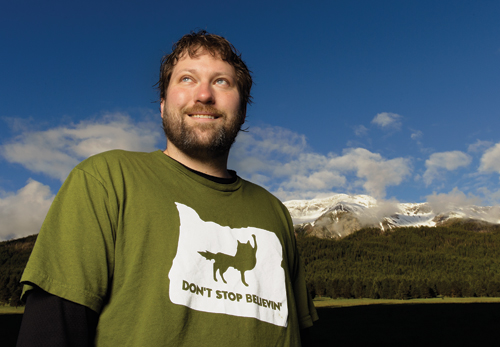 |
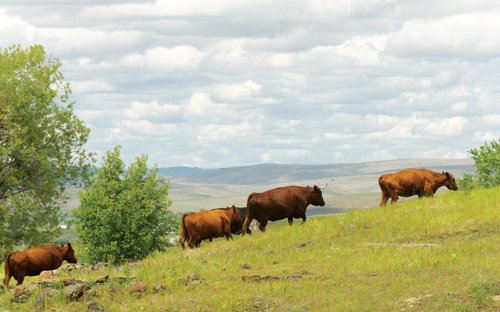 |
Top: Rob Klavins is the founder and leader of Oregon Wild’s Wolf Rendezvous tours.Above: The “wolf highway,” where wolves in the Imnaha pack have attracted tourists and attacked livestock.Below: As the sign indicates, some ranchers believe wolves should not be allowed to roam in Eastern Oregon.// Photos by Joseph Eastburn |
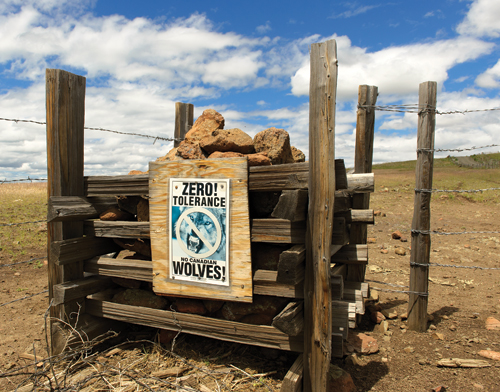 |
Wolves used to range throughout North America.
In 1754 one European explorer remarked seeing “wolves without numbers” as he trekked west from the Hudson Bay. Other 18th- and 19th-century pioneers, like Daniel Boone, described hearing a “howling wilderness.”
The federal government and local cattlemen would generously remunerate bounty hunters — or anyone else — who killed wolves. Grover Myers, a land speculator throughout the Northwest, remembers that even during the Great Depression you could get from $2 to as much as $5 for killing a wolf.
“A hamburger cost 10 cents, and you were lucky to make $1 a day,” 91-year-old Myers tells me. “That was good money back then. They’d cut off the ears and some skin off the face and bring ’em in,” he says.
The last wolf in Oregon was killed around the year 1947. By then these predators were almost extinct in most of North America. Although wolves were reintroduced into Yellowstone National Park and Central Idaho in the mid-1990s as part of a nationwide campaign to return wolves to the ecosystem, it wasn’t until just five years ago that wolves began reestablishing themselves in Eastern Oregon, breaking off from packs in Idaho.
There are now about half a dozen known packs of wolves in Oregon, all living in the Northeast part of the state: the Imnaha pack that Sykes and Rob Klavins from Oregon Wild are tracking this May morning in the Wallowa-Whitman National Forest; the Snake River, Wenaha, Umatilla and Minam River packs inside the Eagle Cap Wilderness; the Walla Walla pack; and a couple other pairs that may not yet have had pups.
In 2005 the Oregon Department of Fish and Wildlife developed a set of rules (the Oregon Wolf Conservation and Management Plan) to ensure wolf recovery while addressing concerns of the livestock industry. Ever since, there has been conflict over these rules, with stakeholders introducing new legislation to, for example, allow people to kill wolves that come within 500 feet of a home.
This spring conservation groups, ranchers and state officials have been negotiating to find a way to balance the protection of both wolves and livestock. In May 2013 a compromise was reached, and in June lawmakers approved a bill that requires implementation of nonlethal dissuasion tactics but allows ranchers and state agents to kill wolves if those efforts fail.
Given the ruckus the wolves have been causing in the Oregon legislature and on social media — one Facebook group started by ranchers, Oregon Wolf Education, shows a snarling wolf baring its fangs next to a big-eyed spotted fawn and a sign that reads “Private Property Rights” — it’s a bit surprising to learn there are fewer than 50 confirmed wolves in the entire state.
There are more than 600 wild wolves in Montana and more than 8,000 in Alaska. Though you may hear them howl and see signs of them in the wild, it is very unlikely you’ll see an Oregon wolf.
The biggest issue is the same one faced by the Europeans who were settling North America’s howling wilderness two centuries ago: Wolves are opportunistic pack hunters and sometimes surround and kill calves, sheep and other livestock.
Though the percentage of livestock lost to wolves is small (less than 1%, according to state and federal statistics), and ranchers in Eastern Oregon who lose livestock or working dogs from wolf kills are financially compensated by the state for their losses, that money is often slow in coming. It can take up to a year, says Sykes, who is also a member of the Wallowa County Wolf Compensation Committee.
Another difficulty is that forensic evidence must be collected confirming the animal was killed by a wolf. Ranchers who graze their cattle unattended on public lands often cannot be compensated because they cannot prove their losses were due to wolves.
“Wolves are large predators, and they are very adept at killing what they need to stay alive.
They are bound to kill cattle,” says Dennis Sheehy, a 66-year-old rancher in Wallowa. Sheehy tells me the wolves cause stress in the area, both to the ranchers themselves and their cow-calf pairs, and that his business has lost cattle to wolves. “You can do certain things to mitigate some of the impact. But if you’re a livestock man, you’re going to lose some of your livestock to the wolves.”
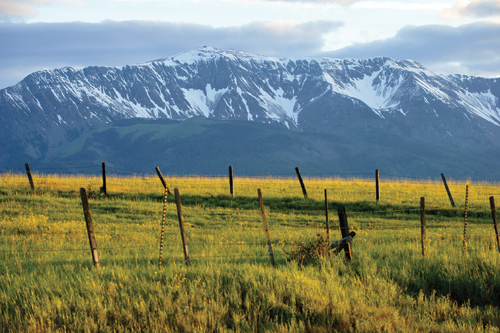 |
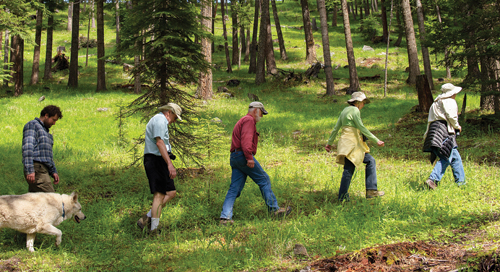 |
Top: The Wallowa Range borders ranchland near Joseph, Oregon.Above: Wally Sykes’ dog, Kumo, half-wolf and half Malamute, tags along on the Wolf Rendezvous tour.Below: Tour members hope for a wolf sighting.// Photos by Joseph Eastburn |
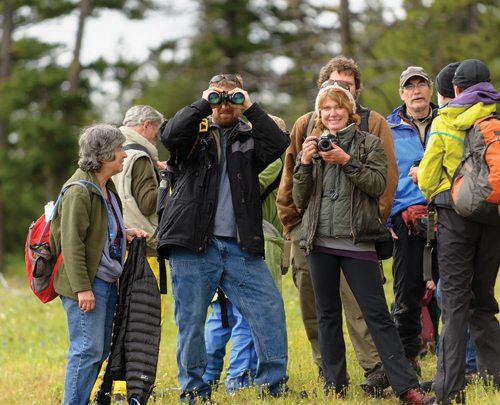 |
Those in favor of bringing back wolves cite the tremendous ecological benefits to having a top-level predator be part of the landscape.
Indeed, several studies show the reintroduction of wolves into Yellowstone triggered a positive ripple effect; wolves cull from the herds of elk and deer, reducing their numbers and encouraging them to roam more widely, which in turn keeps these ungulates from overgrazing the aspens and other trees and shrubs along the river. The aspen-grove growth and revitalized riparian zones in turn cool the water, providing more habitat for beavers and songbirds and leading even to a flourishing of butterflies.
The positive ripples are also economic, advocates say. Since wolves were successfully reintroduced into Yellowstone National Park in 1995, Wyoming, Idaho and Montana have been welcoming at least 40,000 visitors a year eager to attend ranger-led wolf walks and hoping to observe the wolves themselves from a safe distance through spotting scopes.
A 2006 financial analysis done by researchers at the University of Montana found that over 90% of the visitors to Yellowstone came to view wildlife, and that $35.5 million flowed into the local economy as a result of wolf tourism that year alone.
“Wolves have been immensely important to the growth of our business,” says Nathan Varley, co-owner of The Wild Side, a guiding service for visitors interested in seeing wolves, bears and other wildlife in Yellowstone Park. In business for eight years, The Wild Side charges $575 for an 8-hour day for up to five people in a group. “[We] have grown about 20% each year, right through the recession,” Varley explains, “and now work year-round employing up to six guides.”
That kind of success can be replicated in Eastern Oregon, some locals say. “People like predators,” says Mellie Pullman, a professor of supply-chain management at Portland State University who owns a second home in Enterprise, researches sustainable beef and also helps area ranchers develop sustainable business plans. “That’s a lot of the reason people go to national parks. Everyone wants to see wolves and grizzlies. It’s very exciting.”
Pullman believes that ranchers who market their grass-fed, grass-finished beef to high-end restaurants and suppliers in Portland can actually benefit from the presence of wolves by charging more for wildlife-friendly produce that reflects the values of consumers in the western part of the state.
As she serves her guests asparagus omelets, fruit salad and homemade raspberry friands (an Australian pastry) sprinkled with sugar, Diana Hunter, co-owner of Barking Mad Farm, a bed and breakfast outside of Enterprise, likens the breathtaking vistas, diversity of fauna and unspoiled landscape of Eastern Oregon to Africa’s Serengeti, a comparison echoed by others. A herd of bison graze in view of the Hunters’ 1908 three-bedroom accommodations that welcome close to 500 guests a year, but it is the wolves and other wild animals that guests come to see.
“Wolves bring us clients who want to go out and see wolves and be where they are,” Hunter says, though she balks at the phrase “wolf tourism” (too controversial) and prefers to call it ecotourism. With his leathery skin, taupe beaver-felt cowboy hat and blunt speech, Diana’s husband James seems more like a rancher than a B&B owner.
Despite their disagreements with some — a permit to expand their business to a second site on property they own 13 miles away was denied, with one rancher calling the Hunters’ business “detrimental to your direct neighbors” — Hunter is quick to point out that their 42-acre property doubles as a working ranch. They grow hay for sale and graze cattle.
Hunter also invites ranchers to talk with her guests — who are fascinated to hear how they are affected by wolves — and is sympathetic to ranchers who lose livestock to the wolves. “Not everyone thinks wolves are the best thing,” she says. “Sometimes they’re not. If they’re in the wrong place, they are not beneficial.”
Eastern Oregon’s pioneering wolf-tracking outfitters acknowledge the complex and contradictory feelings wolves arouse. “On an emotional level wolves symbolize wildness,” says Joe Whittle, an affable, intense 38-year-old photographer and backcountry wilderness guide who was born and raised in Enterprise and the San Francisco Bay Area. “People respond with a lot of emotion.” For Whittle, who is enrolled in the Caddo tribe, part Lenni-Lenape (Delaware) and part Irish, wolves are vital to his heritage. “Wolves were sacred to us; they play a part in our Caddo creation story,” he explains, adding that the Nez Perce Indians did not kill wolves but instead hunted with their help.
Today Whittle and his blond-haired business partner, Jordan Manley, view wolves as an opportunity. Starting this summer, Whittle’s company, Winding Light Adventures, will be taking visitors out on full-day wildlife viewing and tracking trips for $180 a person. Some will hunt game, others will come to learn about, track and perhaps even catch a glimpse of the wolves. For its part, Oregon Wild’s Wolf Rendezvous trips have filled every year since they were first offered. Klavins, the leader of the trip and an outspoken advocate for wolf recovery, points out that “whether you love them or hate them, the controversy in Eastern Oregon around the wolves is bringing a lot of attention to [that] part of the state.” It has other benefits as well. Sasquatch Brewery in Southwest Portland has created an amber ale named after OR-7, the lone male wolf nicknamed Journey traveling throughout the state unsuccessfully looking for a mate. Green Springs Inn, 25 miles east of Ashland, has designed an entire menu around the same wolf.
Klavins wants people to see the larger picture of positive economic impact. Since people who trek through the wilderness need gear, wolf tourism also indirectly benefits outdoor-gear companies that are Oregon-based: Columbia Sportswear, Keen, Icebreaker (a company that makes merino-wool clothing), LaCrosse Footwear, Bogs, RuffWear (which makes hiking gear for dogs) and Leupold (which makes riflescopes, binoculars and spotting scopes), among many more.
 |
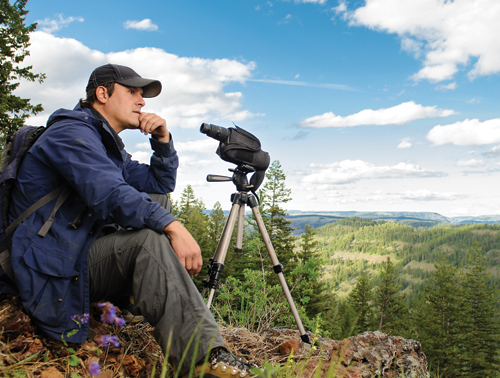 |
Top: Jordan Manley and Joe Whittle have launched wildlife viewing tours for hunters and environmentalists.Above: Whittle, a wildlife tour guid and photographer, is an enrolled member of the Caddo tribe.// Photos by Joseph EastburnBelow: OR-10, a female wolf from the Walla Walla pack. She was fitted with a radio collar and released in 2011 in northern Umatilla County.// Photo courtesy Oregon Department of Fish and Wildlife |
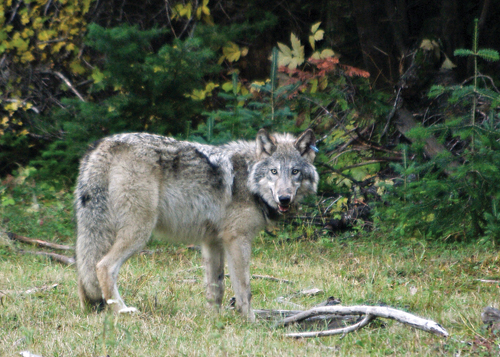 |
It is a sunny day in late May as Klavins and Sykes walk through an alpine meadow interspersed with stands of trees: lodgepole pine, Doug fir, tamarack and the occasional light-green aspen (protected by “exclosures” to keep the cattle, elk and deer that graze on this land from eating them to the ground).
They scramble up a bluff where biscuit root, which has small yellow flowers, is blooming. The smell of wild garlic is in the air. The two men duck under a fallen pine, passing elk droppings and a large, messy pile of bear dung.
Klavins and Sykes stop at a clearing overlooking a vast expanse of trees when a movement in the bushes to the left turns their heads. The chances of seeing an actual wolf may be one in a thousand, but on that day, the duo has hit the jackpot. A grizzled black and gray wolf with large ears and long, thin legs trots toward the group. Ears pricked forward, the wolf raises his head, stops short and stares for just an instant, then tucks his tail between his legs and slinks away.
Protected by the trees and out of sight, he starts yipping, barking and howling — alerting the pack, perhaps, to the presence of intruders. Later I will learn this wolf is OR-4, a wolf that was once targeted for extermination for killing livestock. Wolves remain a lightning rod for controversy in Eastern Oregon.
But as wolf recovery gains traction and as tourists flock in greater numbers to see them, stakeholders are working hard to find a way that ranchers, conservationists and business owners can all come together to benefit.
“It’s a process of people adapting to the reality of what’s here,” admits Sheehy, the rancher who lost cows to wolf predation. “There is not any way in hell that wolves are going to be removed from Eastern Oregon,” he adds. “It’s become a fact of life.” Sheehy chuckles. “If you can make bucks off people who want to go out and look at wolf scat, I guess that’s okay with me.”
Jennifer Margulis is a freelance writer based in Ashland. She can be reached at [email protected].


